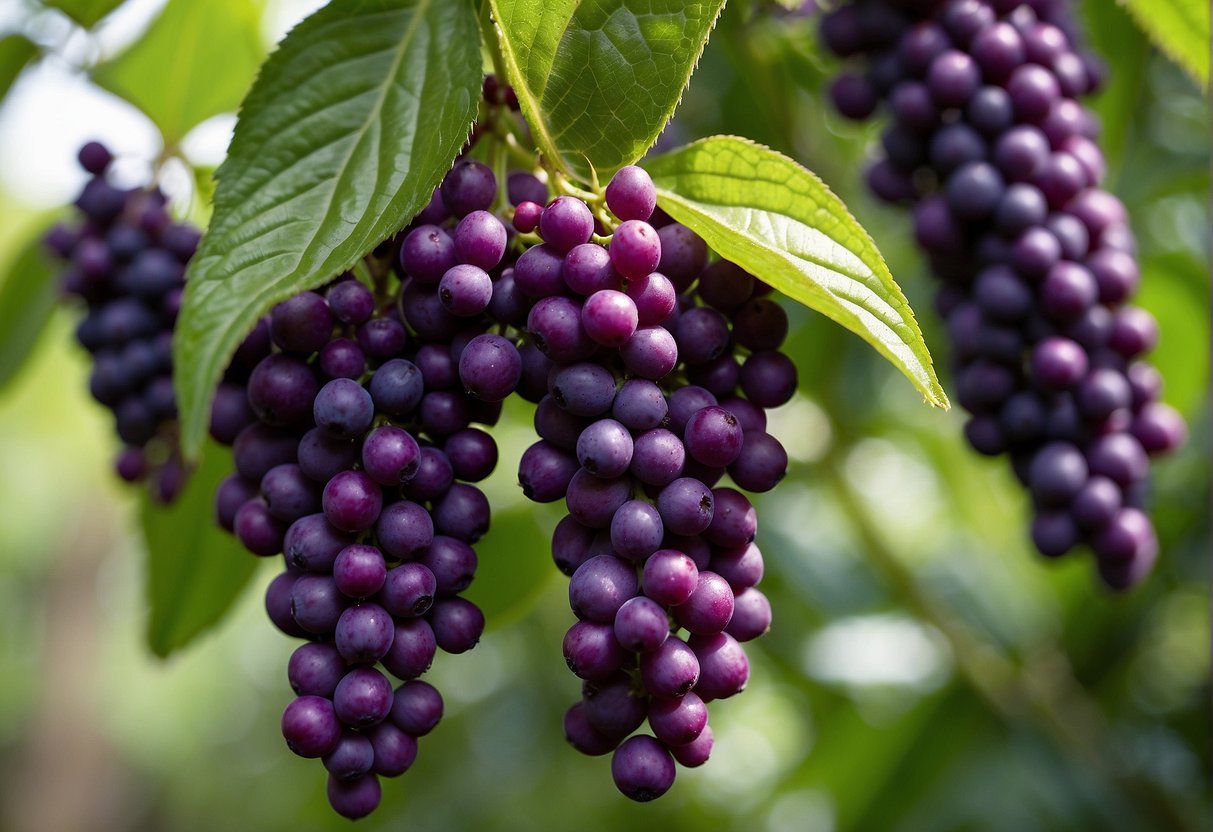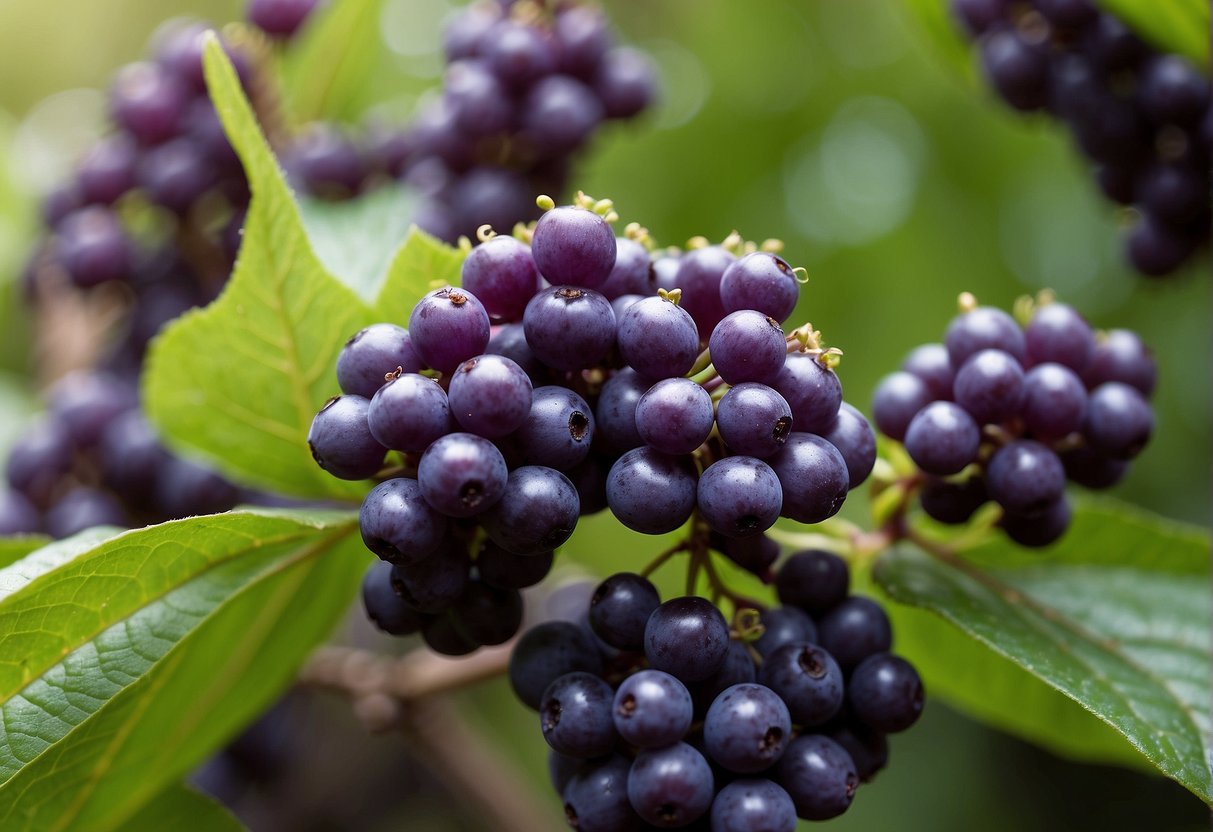If you’re interested in bringing more color to your garden, think about incorporating a beautyberry bush. This deciduous shrub, distinguished by its striking purple berries, originates from the southeastern United States and is favored by landscapers and homeowners alike. However, you might be wondering about the size to which these bushes can grow?

When it comes to size, beautyberry bushes can vary depending on the species and growing conditions. The most common variety, Callicarpa americana, typically grows to be around 4-6 feet tall and wide. However, some cultivars can reach up to 8 feet tall and 10 feet wide. It’s important to keep in mind that these shrubs can spread quickly, so it’s best to give them plenty of room to grow.
If you’re considering adding a beautyberry bush to your garden, it’s important to understand its growth characteristics. In addition to its size, you’ll want to consider factors like sun exposure, soil type, and watering needs. By understanding these factors, you’ll be better equipped to create an environment that allows your beautyberry bush to thrive.
Key Takeaways
- Beautyberry bushes can vary in size depending on the species and growing conditions.
- The most common variety, Callicarpa americana, typically grows to be around 4-6 feet tall and wide.
- When planting a beautyberry bush, it’s important to consider factors like sun exposure, soil type, and watering needs to ensure it thrives.
Growth Characteristics

Beautyberry bushes are deciduous shrubs that are native to North America, Asia, and South America. They are known for their arching branches and clusters of colorful berries that appear in late summer and fall. In this section, we will discuss the growth characteristics of beautyberry bushes, including their size and structure, cultivation requirements, propagation and planting, seasonal development, hardiness and adaptability, native and invasive species, and varieties and hybrids.
Size and Structure
Beautyberry shrubs can grow up to 6 feet tall and wide, with arching branches that give them a graceful appearance. The mature size of a beautyberry bush depends on the cultivar, soil, and growing conditions. Some varieties, such as the American beautyberry (Callicarpa americana), can grow up to 9 feet tall in the right conditions.
Cultivation Requirements
Beautyberry bushes prefer light shade to full sun exposure and well-drained soil with a pH range of 5.5 to 6.5. They are drought-tolerant once established but require regular watering during the first year. Fertilizer is not necessary, but a layer of organic mulch around the base of the plant can help retain moisture and nutrients.
Propagation and Planting
Beautyberry bushes can be propagated from seed or softwood cuttings. Transplanting should be done in the early spring or fall, and cross-pollination is required for fruit production. Flowers appear in clusters in the summer, and the purple berries ripen in the fall.
Seasonal Development
Beautyberry bushes bloom in the summer and produce fruit in the fall. The bloom time and fruit production depend on the cultivar and growing conditions. The leaves turn yellow in the fall before dropping off for the winter.
Hardiness and Adaptability
Beautyberry bushes are hardy in zones 5-8 and can tolerate a range of temperatures and humidity levels. They are adaptable to different soil types and partial shade to full sun exposure.
Native and Invasive Species
The American beautyberry is a native species, while the Japanese beautyberry (Callicarpa japonica) and other Asian species are considered invasive in some areas. The Callicarpa dichotoma and Callicarpa bodinieri are also invasive in some regions.
Varieties and Hybrids
There are several types of beautyberry bushes, including the purple beautyberry, pink beautyberry, white beautyberry, and ‘Welch’s Pink’ beautyberry. Hybrids of different Callicarpa species are also available, such as the Callicarpa x ‘NCCX1’ hybrid.
Ecological Impact and Usage

Wildlife Interactions
Beautyberry bushes are a valuable source of food for various bird species, such as the American Robin, as well as small mammals like raccoons, opossums, squirrels, and armadillos. The magenta-purple berries produced by the beautyberry are high in fat and protein, making them an essential food source for many wildlife species.
Aesthetic and Functional Uses
The beautyberry is a popular garden plant due to its striking flower color and vibrant purple berries that add a pop of color to borders and mass plantings. The beautyberry is also valued for its green leaves, which provide an excellent backdrop for other plants. Additionally, the beautyberry can be used in compost as the leaves break down quickly, adding valuable nutrients to the soil.
Culinary and Cultural Significance
The beautyberry’s fruit is edible and can be used to make jam, jelly, and even wine. The name Callicarpa comes from the Greek words “kallos” meaning beauty and “karpos” meaning fruit, highlighting the beauty of the fruit produced by this plant. Culturally, the beautyberry has been used in traditional medicine to treat various ailments.
Care and Maintenance Challenges
Pruning is essential for maintaining the beautyberry’s shape and promoting new growth. Late winter is the ideal time to prune the plant as it is dormant, and new growth will emerge in the spring. The beautyberry is generally disease and pest-resistant, but root rot can be a problem if the plant is grown in poorly drained soil.
Frequently Asked Questions
What is the typical size range for a fully grown beautyberry bush?
Beautyberry bushes can grow up to 6 feet tall and wide, but their size can vary depending on the cultivar and growing conditions. Some varieties, such as the dwarf beautyberry, stay much smaller, reaching only 2-3 feet in height and spread.
How much space should be allocated for a beautyberry when planting?
When planting beautyberry bushes, it’s important to give them enough space to grow to their full potential. For most varieties, a spacing of 3-4 feet between plants is recommended. This allows them to have enough room to spread out and receive adequate sunlight and air circulation.
What are the ideal growing conditions for beautyberry bushes?
Beautyberry bushes prefer well-draining soil that is rich in organic matter. They also thrive in partial shade to full sun, with at least 4-6 hours of direct sunlight per day. Regular watering and fertilization can help promote healthy growth and fruit production.
Can beautyberry bushes thrive in zone 5 climates?
Beautyberry bushes are generally hardy in USDA zones 6-10, but some cultivars can tolerate colder temperatures. If you live in zone 5, it’s best to choose a variety that is specifically bred for cold hardiness, such as ‘Profusion’ or ‘Lilacina’.
What are the common issues associated with cultivating American beautyberries?
Beautyberry bushes are relatively easy to grow and maintain, but they can be susceptible to certain pests and diseases. Some common issues include leaf spot, powdery mildew, and aphids. Regular pruning and proper sanitation practices can help prevent and control these problems.
Is there a risk of beautyberry bushes becoming invasive in certain regions?
While beautyberry bushes are not considered invasive, they can self-seed and spread if not properly maintained. To prevent them from becoming a nuisance, it’s important to remove any unwanted seedlings and limit their spread by pruning back the branches.














